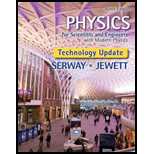
Concept explainers
(a)
Show that an electron in a classical hydrogen atom spirals into the nucleus at a rate of
(a)
Answer to Problem 6P
An electron in a classical hydrogen atom spirals into the nucleus at a rate of
Explanation of Solution
The uniform circular motion of the electron as a particle about the proton in the hydrogen atom experiences a force which can be expressed as,
Here,
The force can be expressed in terms of Newton’s second law,
Here,
Use equation (I) in equation (II) and solve for
Write the expression for the centripetal acceleration.
Here,
Use equation (II) in equation (IV),
The value of the
Write the expression for the total energy,
Here,
Write the expression for the kinetic energy.
Write the expression for the potential energy.
Use equation (VIII) and (IX) in equation (VII),
Use equation (VI) in equation (X),
The given expression connecting
Use equation (XI) and equation (III) in equation (XII),
Conclusion:
Therefore, from equation (XIII) it is shown that an electron in a classical hydrogen atom spirals into the nucleus at a rate as
(b)
The time interval over which the electron reaches
(b)
Answer to Problem 6P
The time interval over which the electron reaches
Explanation of Solution
Write the expression for the time interval in terms of
Solve equation (XIII) for
Conclusion:
Substitute
Therefore, the time interval over which the electron reaches
Want to see more full solutions like this?
Chapter 42 Solutions
Physics for Scientists and Engineers with Modern Physics, Technology Update
- (a) For a spherical capacitor with inner radius a and outer radius b, we have the following for the capacitance. ab C = k₂(b- a) 0.0695 m 0.145 m (8.99 × 10º N · m²/c²)( [0.145 m- 0.0695 m × 10-11 F = PF IIarrow_forwardA pendulum bob A (0.5 kg) is given an initialspeed of vA = 4 m/s when the chord ishorizontal. It then hits a stationary block B (1kg) which then slides to a maximum distanced before it stops. Determine the value of d.The coefficient of static friction between theblock and the plane is μk = 0.2. The coefficientof restitution between A and B is e = 0.8.Ans: d=1.0034 marrow_forwardFigure 29-43 Problem 12. ••13 In Fig. 29-44, point P₁ is at distance R = 13.1 cm on the perpendicular bisector of a straight wire of length L = 18.0 cm carrying current i = 58.2 mA. (Note that the wire is not long.) What is the magnitude of the magnetic field at P₁ due to i? P2° R R Larrow_forward
- Checkpoint 1 The figure shows the current i in a single-loop circuit with a battery B and a resistance R (and wires of neg- ligible resistance). (a) Should the emf arrow at B be drawn pointing leftward or rightward? At points a, B C R b, and c, rank (b) the magnitude of the current, (c) the electric potential, and (d) the electric potential energy of the charge carriers, greatest first.arrow_forwardPls help ASAParrow_forwardPls help asaparrow_forward
 Principles of Physics: A Calculus-Based TextPhysicsISBN:9781133104261Author:Raymond A. Serway, John W. JewettPublisher:Cengage Learning
Principles of Physics: A Calculus-Based TextPhysicsISBN:9781133104261Author:Raymond A. Serway, John W. JewettPublisher:Cengage Learning Physics for Scientists and Engineers with Modern ...PhysicsISBN:9781337553292Author:Raymond A. Serway, John W. JewettPublisher:Cengage Learning
Physics for Scientists and Engineers with Modern ...PhysicsISBN:9781337553292Author:Raymond A. Serway, John W. JewettPublisher:Cengage Learning College PhysicsPhysicsISBN:9781305952300Author:Raymond A. Serway, Chris VuillePublisher:Cengage Learning
College PhysicsPhysicsISBN:9781305952300Author:Raymond A. Serway, Chris VuillePublisher:Cengage Learning Glencoe Physics: Principles and Problems, Student...PhysicsISBN:9780078807213Author:Paul W. ZitzewitzPublisher:Glencoe/McGraw-Hill
Glencoe Physics: Principles and Problems, Student...PhysicsISBN:9780078807213Author:Paul W. ZitzewitzPublisher:Glencoe/McGraw-Hill
 Modern PhysicsPhysicsISBN:9781111794378Author:Raymond A. Serway, Clement J. Moses, Curt A. MoyerPublisher:Cengage Learning
Modern PhysicsPhysicsISBN:9781111794378Author:Raymond A. Serway, Clement J. Moses, Curt A. MoyerPublisher:Cengage Learning





